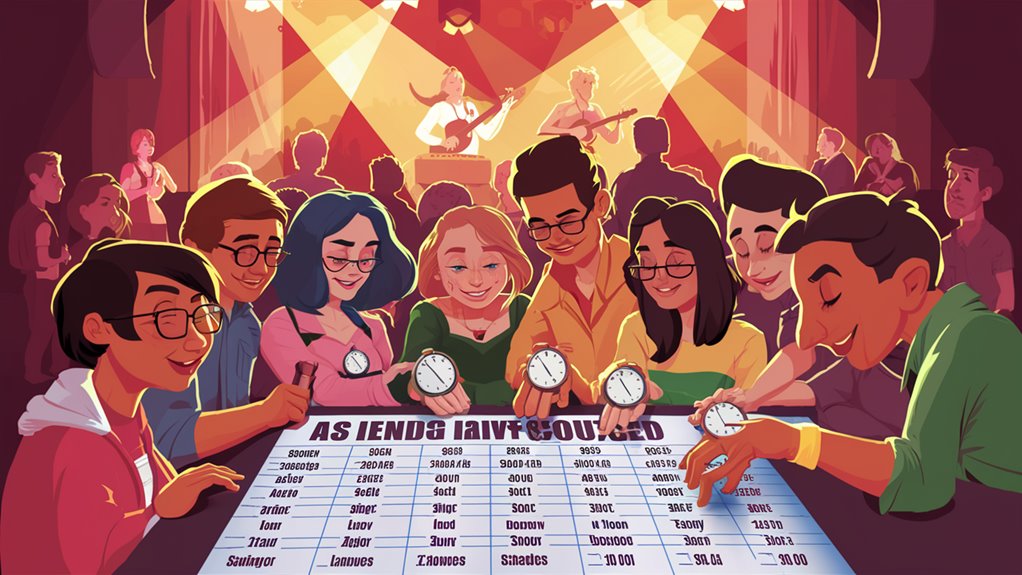
How to Make Sure You Have the Best Karaoke Night at Any Place

Must-Have Setup and Tools
To set up the best karaoke spot, start with great sound and easy views. Put sound-soaking stuff on walls and make sure most can see the stage from where they sit. You need good tools like:
- Loud speakers (at least 300 watts)
- A good 8-channel mixer
- Well-placed screens
- Clear lyric displays
Better Sound System
Good sound is key for great karaoke. Set your system with:
- Right speaker spots for even sound
- Mics set up to stop echoes
- Right sound levels for music and singing
- Different sound feeds for singers
Pick the Right Songs
Build a big song list for all tastes:
- Hot new hits
- Old favorites from all types
- Songs from around the world
- Songs sorted by how hard they are
Manage Performances Well
Use smart time plans:
- 3-4 minute singing slots
- Orderly turn system
- Breaks every hour
- Digital line-up system
Build a Community
Make the crowd a part of it by:
- Theme nights each week
- Shout-outs for great singers
- Easy song requests
- karaoke parties
- Frequent contests
- Connect on social media
Turn your place into an amazing karaoke spot by keeping up these standards and always getting better from what your guests say and the latest trends.
Pick Your Place Well
Choose the Best Spot for Karaoke
Space Needs
How big the place is matters a lot for a great karaoke night.
The best karaoke place should fit 50-150 people, giving the right crowd feel and enough room for all. This size keeps the energy up and still comfy for everyone.
Think About Sound
Better sound needs the right room set-up. The best places have:
- Stuff like carpets and curtains that soak up sound
- At least 10-foot high ceilings for sound to spread right
- Placed to cut down on echo and noise issues
Layout and Look
Smart layout changes how well karaoke goes. Key parts include:
- Stage seen from most seats
- Clear walkways from crowd to stage
- Bar away from the main sound tools
- Space between sound gear and seats to cut interference
Right spot for sound tools is a must for good tech set-up and guest ease. The best set-up keeps sound top-notch while making sure people can move around well.
Know Your Songs
Be Smart About Picking Songs
Get a Mix of Songs
A good song list is key for karaoke success. Keep a mix of tunes from different times, kinds, and languages to keep guests happy.
Update your list often with the latest hits and keep old gems that always get people singing.
Sort Songs Smartly
Use a system to sort by ease to help singers feel good and enjoy. Mark easy songs and keep tougher ones separate for those who can handle them.
Must-have crowd-pleasers like “Sweet Caroline” and “Don’t Stop Believin'” should be in your mix, plus some less known ones for regulars.
Keep Performances Fresh
Watch how often songs are picked to keep things fun. Plan when to bring back popular tunes and watch what the crowd thinks.
Drop songs that don’t work well. Tailor your song picks to fit whether you’re in a party spot or a more formal setting.
Make sure all your songs are okay to use by getting them from the right places.
Song Must-Haves
- Different styles and times
- Songs in several languages
- Easy to tough tunes
- How much people like them
- What fits the venue
- Staying within the rules
Practice Makes Perfect
Get Better at Running Karaoke
Daily Practice Tips
Top-notch karaoke hosting takes lots of practice and planning.
Set aside two hours each day to work on things like how you introduce songs, moving smoothly between them, and using the mic well.
Watch your own videos to get better at how you talk, say words clearly, and sing.
Know Your Equipment Well
Learn all about your karaoke gear, including mixer settings and how to use the software.
Practice important skills:
- Keeping sound levels right
- Stopping feedback
- Switching mics smoothly
- Reading the room’s mood
- Handling how sound moves in the space
Plan for Problems
Run shows without a hitch by knowing what to do if something goes wrong.
Have plans ready for:
- Tool troubles
- Last-minute song changes
- Cancelations
- Other issues
Write down tough spots in a log and work on solutions.
Get better through role-playing with others until you can deliver smoothly and make the place feel great.
Time Your Show Right
Make Sure the Timing is Good

Set Up Good Turn-Taking
Well-run karaoke places keep an eye on timing all through the night.
Use a clear system for turns with 3-4 minute turns to keep the energy up and stop the crowd from getting too tired.
The best plan gives everyone one song at first, then lets people go again after everyone has had a turn, making sure stage time is shared fairly.
Manage the Line Digitally
Running great karaoke needs smart digital line systems to watch wait times and plan well.
Letting singers know they’re up in three songs gives them time to get ready and cuts down on nerves.
This organized way stops any empty spots that can make the night drag and hurt the mood and feel of the place.
Plan Breaks Wisely
Smart show timing means 15-minute breaks every two hours. These breaks help with:
- Checks on the sound system
- Time for song picking
- More drinks sold
- Good rest for better shows
This schedule helps everyone, new and old singers alike, feel good about their time and keeps the night running well.
Basics of Sound Tools
What You Need for Sound at Karaoke
Main Things for Pro Karaoke Set
Any pro karaoke spot needs four main sound tools: a strong PA system, a good audio mixer, top mics, and a solid karaoke system.
These parts must work together for a top sound for singers and the crowd.
PA System and How to Set Speakers
Powerful speakers should give out at least 300 watts each to make sure the sound is clear and full.
Put speakers in smart spots at the right heights and angles to cover the whole place with good sound.
Great amps keep the sound good even when it’s very busy.
Mixing Sounds Right
The mixer should have at least 8 channels and controls for fine tuning to manage the sound well.
Built-in sound effects, like reverb, make singing sound better while keeping the sound clear.
Separate controls for each channel let you balance the music and live singing just right.
Pick the Right Mics
Good singing mics should have options for both wireless and corded use:
- At least 2 wireless for moving around
- At least 2 corded as back-up
- Well-known types like Shure SM58 or Sennheiser e835
- Must resist feedback
- Must catch all singing tones
Must-Have Extras and Watching
Key extra tools include:
- Sturdy mic stands
- Extra cables
- Systems to stop feedback
- Monitors for watching performances
- Players that can handle many karaoke formats
- Displays that are easy to see
Manage How You Look On Stage
Top Tips for Handling Stage Presence
Smart Stage Design & Layout
Good stage spots are key for getting the crowd involved. Set your stage so most can see well.
Pro lights need at least two LED spotlights on the main area, with smart lights around the edges for more depth.
Where to Put Tech Gear
Correct monitor spots play a big part in how well performances go. Place floor monitors at just the right angle toward where singers stand while keeping the crowd’s view clear.
Main speaker spots should be up high with angles pointing down to cut down on echo. Use subtle tape marks on the floor to show the best places to stand.
Looks and Space for Performing
Optimize backdrops with either top-notch black drapes or LED screens depending on what the place needs.
Keep clear spots for performing with set areas for key gear like microphone stands and digital screens.
KJ station spots should let you watch both the singers and the crowd while getting to the stage fast.
Making the Best Performance Spots
- Stage view numbers: at least 75% can see
- Necessary lights: LED spotlights + more lights
- Monitor angles: angled just right
- Speaker places: up high, angled down
- Marking spots: smart tape use
- Tool zones: set spots for stands and screens
Grow Your Karaoke Crowd
Connect Online
Being on social media helps grow a strong karaoke group.
Start a Facebook group or use an Instagram tag to help singers connect outside of events. These places become spots where singers can post videos, swap tips, and keep up the fun between live nights.
Fun Theme Nights
Plan special music nights focused on specific types of music and decades.
Set up nights like “80s Rock Night” or “Country Music Mondays” to build excitement and bring in people who love those sounds. Theme karaoke gives clear ideas for the night and gets people into dressing up, adding more fun. 호치민 퍼블릭가라오케
Shout-Outs and Prizes
Set up a strong singer shout-out program with awards each month and big moments.
Keep track with a digital system that gives points for coming often and doing well. Celebrate big moments like the “100 Songs Club” or “Master of a Music Type” to keep singers coming back.
Support Each Other
Make a help system where seasoned singers help new ones. Set up support groups through fun things like:
- Watching music awards together
- Going to local concerts
- Voice workshops
- Sessions on how to perform better
Get and Use Feedback
Have many ways to hear from singers through:
- Online feedback forms
- Ways to suggest anonymously
- Meetings each month
- Workshops to get better
Use what people say to show you value their ideas and to keep making the group better. Change your plans and grow your events based on what your members like.


